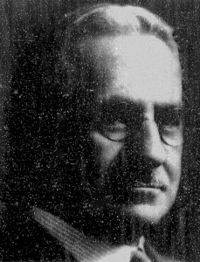Albert Kahn (1869-1942), Architect
Albert Kahn was born March 21, 1869 in Germany.[3][4][6] He was the oldest son of a family that immigrated to Detroit, Michigan from Germany. When he arrived, Albert was 11. He first worked as an apprentice in an architectural firm, was fired, and was then hired at the firm Mason & Rice. He married Ernestine Krolik in 1896, and they had three daughters and 1 son. Kahn worked in various architectural partnerships, including Packard Motor Car Company, during the early 1900s. Henry Ford asked Kahn to build his first car factories, and together they created Ford's visions for a site that would consolidate all Model T production operations in one factory. In 1938, Kahn's firm was responsible for 19% of America's architect-designed factories.[6] He has been said to have “pioneered the design of the modern factory.”[5] Overall, Albert Kahn was responsible for the design of more than 2,000 factories. His clients included Henry Ford, the Fisher brothers, the Dodge brothers, and Walter Chrysler, as well as the Soviet Government and American military.[6] Kahn became a member of the American Institute of Architects in 1902 and became a fellow in 1918. Additionally, he belonged to the Michigan Society of Architects and the Detroit Institute of Architects. He passed away on December 8, 1942 in Detroit, Michigan.[3][4]
This page is a contribution to the publication, Place Makers of Nebraska: The Architects. See the format and contents page for more information on the compilation and page organization.
Contents
Compiled Nebraska Directory Listings
Omaha, Nebraska, 1904, 1909-1922
Educational & Professional Associations
____: draftsman, Mason & Rice, Detroit, Michigan.[6]
1890: Traveled Europe
1903-____: architect, Packard Motor Car Company [6]
1904-1922: Not listed, Omaha, Nebraska.
1915: Registered Professional Architect (by exemption), Michigan, September 3, 1915.[4]
1936: Registered Professional Architect (by examination), Michigan, June 30, 1936, #61.[4][a]
1941: Registered Professional Architect, Nebraska, April 18, 1941, A-122.[4][b]
Buildings & Projects
Dated
600 ft. Veranda of Grand Hotel (1887), Mackinac Island, Michigan.[6]
Pneumatic-hammer Factory (1900), Detroit, Michigan.[6]
Packard Motor Car Company plant (1903), Detroit, Michigan.[6]
Brandeis-Millard House (1904), 500 S. 38th St., Omaha, Nebraska.[1][2] (DO09:0317-002) National Register narrative
Brandeis-Millard Carriage House (1904), 3815 Dewey Ave., Omaha, Nebraska.[2] (DO09:0317-012)
Packard Motor Car Company plant building #10 (1905), Detroit, Michigan.[6]
George Pierce Plant (1906), Buffalo, New York, [6][b]
Ford Motor Company Service Building (1910), 1916-1920 Harney St., Omaha, Nebraska.[2] (DO09:0124-040)
“Crystal Palace” Highland Park Ford plant (1910), Highland Park, Michigan.[6]
Omaha Ford Motor Company Assembly Plant (1915-1916), 901 N 16th St., Omaha, Nebraska.[1][2] (DO09:0129-003)
“The Rouge” Ford plant (1922), by Rouge River, Dearborn, Michigan.[6]
Residence of Edsel Ford (1927), northeast of Detroit, Michigan.[6]
Chevrolet Parts Depot/Universal Trades School (1928), 902 Capitol Ave., Omaha, Nebraska.[2] (DO09:0125-029)
Lighthouse (1929), Belle Isle, Detroit, Michigan.[6]
Factories for Stalin's First Five Year Plan (1929), Moscow, Russia.[6]
Personnel Building (Building A); Martin Bomber Plant (1941), Nelson Drive, Offutt Air Force Base, Sarpy County, Nebraska. (SY04-143)
Boiler House; Martin Bomber Plant (1941), Nelson Drive, Offutt Air Force Base, Sarpy County, Nebraska. (SY04-139)
Undated
Detroit Arsenal (n.d.) Detroit, Michigan.[5]
General Motors building (n.d.), Detroit, Michigan.[6]
Fisher building (n.d.), Detroit, Michigan.[6]
Children's Hospital (n.d.). Detroit, Michigan.[6]
Library for James Scripps (n.d.), Detroit, Michigan.[6]
Conservatory (n.d.), Belle Isle, Detroit, Michigan.[6]
Clements Library (n.d.), University of Michigan, Ann Arbor, Michigan.[6]
Angell Hall (n.d.), University of Michigan, Ann Arbor, Michigan.[6]
“The Farm” summer residence of the Kahn family (n.d.), 20 miles northwest of Detroit, Michigan.[6]
Parke-Davis Pharmaceutical Company manufacturing buildings (n.d.), Detroit, Michigan.[6]
Notes
a. Registered in Wisconsin, Colorado, California, Virginia, North Carolina, Alabama, Oregon, Texas.[4]
b. This project done in partnership with the Boston firm, Lockwood, Greene & Company.
References
1. Listed in the National Register of Historic Places.
2. City of Omaha Planning Department, Landmarks Heritage Preservation Commission, Database, Query on Architects, May 20, 2002; courtesy of Lynn Meyer, Preservation Planner.
3. AIA Historical Directory of American Architects: A Resource Guide to Finding Information About Past Architects, accessed May 18, 2010, http://communities.aia.org/sites/hdoaa/wiki/Wiki%20Pages/ahd1022913.aspx
4. Application for Registration to Practice Professional Engineering and Architecture, Nebraska State Board of Examiners for Professional Engineers and Architects, February 19, 1941. Nebraska State Historical Society RG081 SG2.
5. Joseph S. Murphey, Building the Arsenal of Democracy: A Survey of the World War II Military-Industrial Army Ordinance Complex (August 1993), 6.
6. Joe Sherman, “Like the factories he designed, Albert Kahn lived to work,” Smithsonian Vol. 25 No. 6 (September 1994), 48-59.
Other Sources
Entry in Henry F. Withey, A.I.A., and Elsie Rathburn Withey, Biographical Dictionary of American Architects (Deceased) (Los Angeles: New Age Publishing Company, 1956. Facsimile edition, Hennessey & Ingalls, Inc., 1970).
Entry in Macmillan Encyclopedia of Architects (New York: Macmillan, 1982). [3]
Hawkins Ferry, The Legacy of Albert Kahn (Detroit: Wayne State University Press, 1987).
Return to Top of Page
Page Citation
D. Murphy, “Albert Kahn (1869-1942), Architect,” in David Murphy, Edward F. Zimmer, and Lynn Meyer, comps. Place Makers of Nebraska: The Architects. Lincoln: Nebraska State Historical Society, February 2, 2015. http://www.e-nebraskahistory.org/index.php?title=Place_Makers_of_Nebraska:_The_Architects Accessed, April 24, 2024.
Contact the Nebraska State Historic Preservation Office with questions or comments concerning this page, including any problems you may have with broken links (see, however, the Disclaimers link at the bottom of this page). Please provide the URL to this page with your inquiry.
